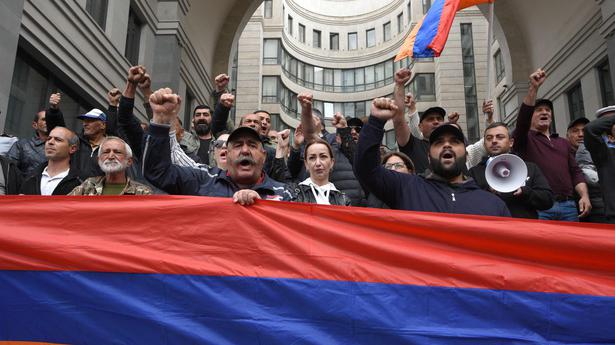
Explained | The Azerbaijan-Armenia conflict over Nagorno-Karabakh and the status of peace talks
The Hindu
The breakaway region of Nagorno-Karabakh in the South Caucasus has been at the centre of three wars and multiple clashes between Azerbaijan and Armenia
The story so far: Armenian Prime Minister Nikol Pashinyan and Azeri President Ilham Aliyev announced on May 23 that their respective countries would be setting up border security and delimitation commissions, signalling a step towards resolution of a decades-long conflict over the Nagorno-Karabakh Enclave. The announcement was made after trilateral talks initiated by European Council President Charles Michel. Both leaders also agreed to start working on a peace plan.
The talks between the two leaders have triggered protests in the Armenian capital of Yerevan and other parts of the country. Protesters and the Opposition believe that Mr. Pashinyan is conceding too much ground in the peace talks and have demanded his resignation.
Nagorno-Karabakh is a landlocked, mountainous and forested region with a population of around 150,000, falling within the boundaries of Azerbaijan. Nagorno-Karabakh, called Artsakh in Armenian, hosts a predominantly ethnic Armenian population with an Azeri minority. It is located in the South Caucasus region, which straddles the border between eastern Europe and western Asia and spans the southern part of the Caucasus mountains. It is roughly made up of modern-day Armenia, Azerbaijan, and Georgia. The capital of Nagorno-Karabakh is Stepanakert, with Susha being another major city in the region.
Nagorno-Karabakh, which was once a part of the Armenian Kingdom, has been ruled by several empires over the centuries — the Ottomans, the Persians, and the Russians. Tsarist Russia ruled over the South Caucasus for most of the 19th Century but its influence lessened post the 1917 Russian Revolution which brought the Bolsheviks to power.
Armenia, Azerbaijan and Georgia later became separate Republics, with the Azeris incorporating Nagorno-Karabakh into their Republic. During the First World War, the Ottomans, aided by Azeris, attacked the south Caucasus, especially targeting ethnic Armenians. As the Ottomans retreated at the end of the World War, Azerbaijan and Armenia descended into a full-blown war in 1920, which had a devastating effect on Armenians in Nagorno-Karabakh.
Soon, the Bolsheviks took over south Caucasus to expand Soviet influence and Azerbaijan, Armenia, and Georgia became Soviet Republics. The Soviets officially placed Nagorno-Karabakh as an autonomous Oblast (administrative region) in Azerbaijan’s territory, despite the chiefly Armenian population. As Soviet power began to wane in the 1980s, the ethnic Armenian population of Nagorno-Karabakh expressed a desire to be reunited with their roots and become a part of Armenia, organising a vote for the same in 1988.
This did not go down well with Azerbaijan and military clashes ensued. With the dissolution of the USSR in 1991, Armenia and Azerbaijan became independent countries, and this time, Armenian rebels in Nagorno-Karabakh declared it an independent territory, which was not recognised internationally. This led to an open war between Armenia and Azerbaijan which lasted till 1994. The war killed nearly 30,000 people and caused numerous ethnic Azeris to flee Karabakh and Armenia. Some Armenians in parts of Azerbaijan fled too.













